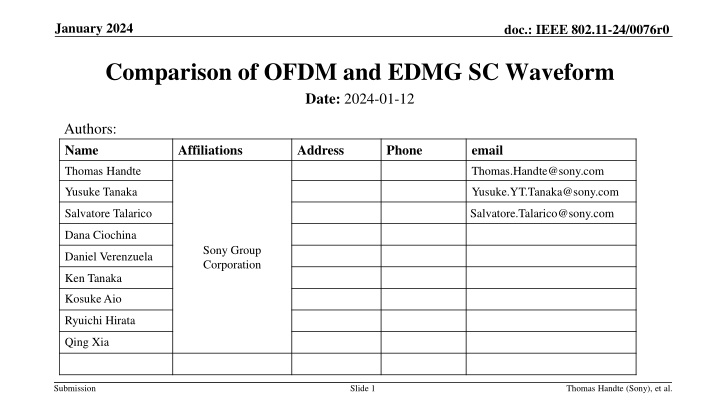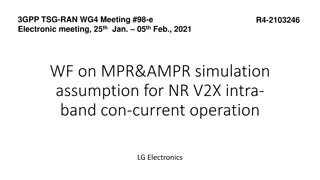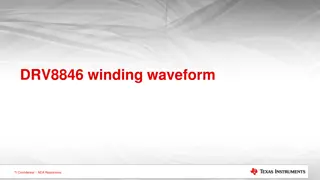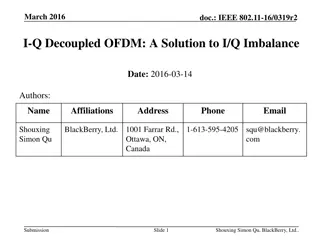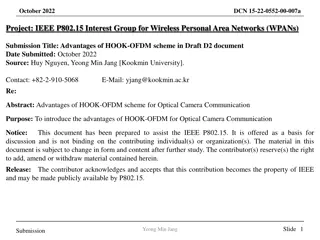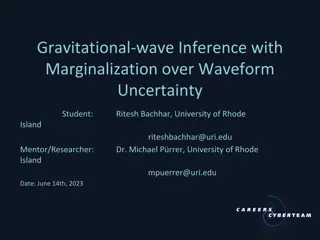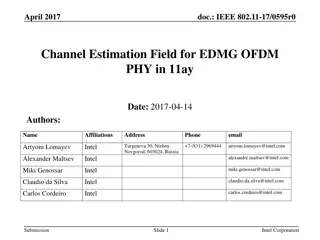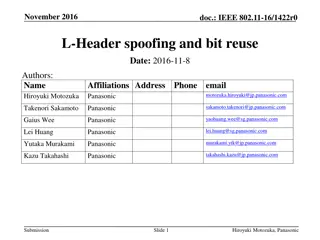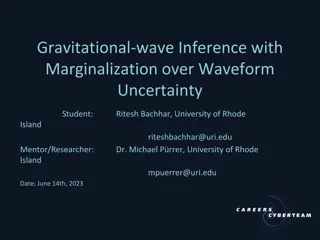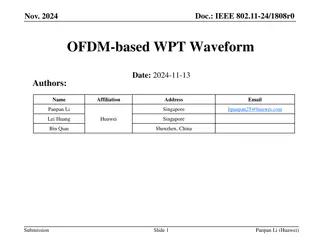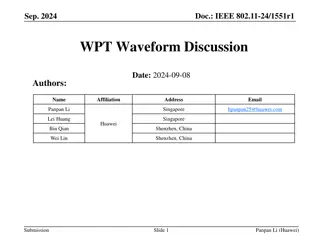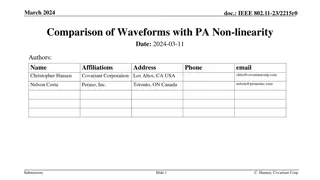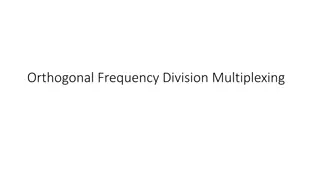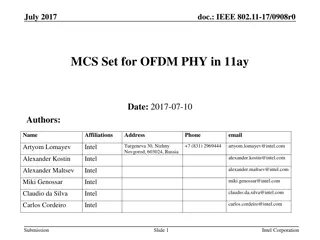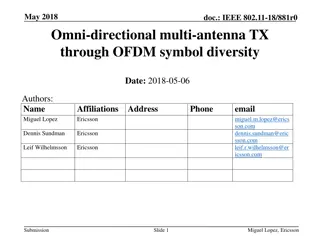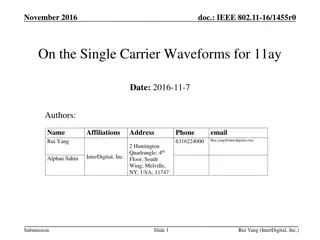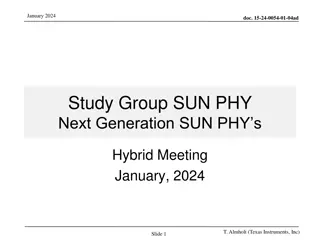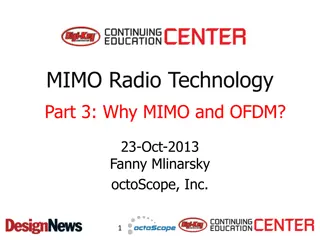Comparison of OFDM and EDMG SC Waveform
"This document analyzes the performance and design considerations of OFDM and EDMG single carrier (SC) waveforms for integrated mmWave applications. It discusses RF frontend challenges, power amplifier characteristics, PA backoff requirements, and bandwidth implications in mmWave technology."
Download Presentation

Please find below an Image/Link to download the presentation.
The content on the website is provided AS IS for your information and personal use only. It may not be sold, licensed, or shared on other websites without obtaining consent from the author.If you encounter any issues during the download, it is possible that the publisher has removed the file from their server.
You are allowed to download the files provided on this website for personal or commercial use, subject to the condition that they are used lawfully. All files are the property of their respective owners.
The content on the website is provided AS IS for your information and personal use only. It may not be sold, licensed, or shared on other websites without obtaining consent from the author.
E N D
Presentation Transcript
January 2024 doc.: IEEE 802.11-24/0076r0 Comparison of OFDM and EDMG SC Waveform Date: 2024-01-12 Authors: Name Affiliations Address Phone email Thomas Handte Thomas.Handte@sony.com Yusuke Tanaka Yusuke.YT.Tanaka@sony.com Salvatore Talarico Salvatore.Talarico@sony.com Dana Ciochina Sony Group Corporation Daniel Verenzuela Ken Tanaka Kosuke Aio Ryuichi Hirata Qing Xia Submission Slide 1 Thomas Handte (Sony), et al.
January 2024 doc.: IEEE 802.11-24/0076r0 Introduction Goals of integrated mmWave [1,2] are to combine mmWave and sub-7 GHz via MLO framework reuse sub-7GHz OFDM waveform for application in mmWave Studies have been done which compare parameters of upclocked 11ac waveform with EDMG OFDM waveform [3,4] However, EDMG OFDM waveform is optional Performance of any new waveform should be compared to EDMG single carrier (SC) which is the only mandatory PHY mode IMMW should not compromise its performance vs. EDMG SC This submission compares OFDM with SC waveform and provides some design considerations Particularly, we analyze the output power backoff of the power amplifier (PA) We derive the bandwidth (BW) at which the OFDM waveform is expected to achieve same link budget/ range as EDMG SC Submission Slide 2 Thomas Handte (Sony), et al.
January 2024 doc.: IEEE 802.11-24/0076r0 RF frontend in mmWave A mmWave RF frontend is challenging to implement Need for power splitters, switches, and phase shifting circuitries to implement analog beamforming Those components have non-zero loss RF power is scarce resource A power amplifier (PA) for 60 GHz has typ. 10dBm output power => various PAs reside in an RF frontend It is difficult to do digital predistortion (DPD) for all [5] Thus, consideration of PA characteristic is very important For our analysis, we use the PA model of EDMG evaluation methodology [6] ???? average transmit power maximum transmit power PA backoff parameter is defined as ?? = 10log10 ???? ???? ???? Submission 3 Thomas Handte (Sony), et al.
January 2024 doc.: IEEE 802.11-24/0076r0 PA backoff (BO) considerations PA BO depends on waveform SC requires BO 0.5dB for BPSK/QPSK BO 3dB for 16-QAM OFDM requires BO 8dB for BPSK/QPSK/16-QAM BO numbers are designed to meet spectral mask to achieve about -20dB EVM Higher order modulation (>16-QAM) may require higher backoff E.g. EDMG 64-QAM has -27dB as EVM requirement for EDMG SC and EDMG OFDM PHY IMMW waveform may require slightly different BO because of Higher robustness due to LDPC with longer CWs having different guard bands BO numbers correlate with recommendation of [6] Submission 4 Thomas Handte (Sony), et al.
January 2024 doc.: IEEE 802.11-24/0076r0 PA Backoff and Bandwidth implications A PA achieves lower average transmit power with increasing BO SC achieves 7.5dB (QPSK) or 5.5dB (16-QAM) more average transmit power compared to OFDM A lower bandwidth increases power spectral density [dBm/MHz] IMMW targets lower bandwidth compared to EDMG Limits to power spectral density may apply for lower bandwidths in some countries E.g. EIRP 40dBm and 23dBm/MHz (ETSI) BW 50 MHz Both effects need to be studied to estimate link budget/ range of the new waveform Submission 5 Thomas Handte (Sony), et al.
January 2024 doc.: IEEE 802.11-24/0076r0 Achievable Spectral Density Upper bound of spectral density depending on waveform type Reflecting BO requirements SC has an advantage over OFDM of at least 5dB OFDM achieves same spectral density as SC waveform for a BW of 310 MHz (QPSK) for a BW of 550 MHz (16-QAM) 320 MHz seems to be reasonable choice for IMMW waveform 160 / 640 MHz would result in 3dB more / less link budget compared to SC QPSK which could be acceptable Better than EDMG SC QPSK Worse than EDMG SC QPSK Submission 6 Thomas Handte (Sony), et al.
January 2024 doc.: IEEE 802.11-24/0076r0 Conclusion IMMW OFDM waveform needs to be compared to EDMG SC OFDM and SC waveform have different requirements for PA BO Different bandwidths are discussed for IMMW compared to EDMG IMMW should not compromise its performance vs. EDMG Comparison shows that an OFDM waveform with a bandwidth of 320 MHz achieves roughly same link budget/ range as EDMG SC Slightly higher bandwidth may be feasible and acceptable from QoE perspective Significantly higher bandwidth comes with link budget/ range reduction unless compensated by appropriate means (e.g. PAPR reduction, higher beamforming gain) A reasonable operating bandwidth of IMMW seems to be 160 640 MHz Especially in the light that a simple PHY is desired for IMMW Submission 7 Thomas Handte (Sony), et al.
January 2024 doc.: IEEE 802.11-24/0076r0 References [1] 11-23/1819r1 Integrated mmWave Design Considerations [2] 11-23/1905r0 High Level Thoughts on IMMW [3] 11-22/1395r0 Thoughts on high frequency band [4] 11-22/1872r0 Considerations on PHY designs for mmWave band [5] Why Millimeter Wave Requires a Different Approach to DPD and How to Quantify Its Value | Analog Devices [6] 11-15/0866r4 11ay evaluation methodology Submission 8 Thomas Handte (Sony), et al.
